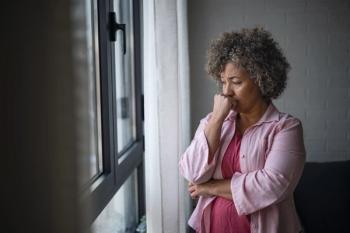
Surviving Survivorship
Surviving is harder than it looks…
TALES FROM THE CLINIC
In this installment of Tales From the Clinic: The Art of Psychiatry, we accompany Anna, a breast cancer survivor, in her journey with anxiety and interpersonal and self-image issues post-remission. Through a deeply moving account, this fictional case reminds us that survival is harder than it looks, and often necessitates both pharmacological and psychotherapeutic interventions.
Case Study
“Anna,” a 36-year-old female with breast cancer, in remission, and no prior psychiatric history is referred to psychiatry with panic attacks. She has less confidence in her ability to fulfill her prior role as a working mother—she has concerns of inability to meet the physical demands of raising her 2 young children, compounded by the guilt that her spouse is now their primary
Cancer Effects on the Family
Anna is referred to the clinic by her oncologist after she screened positive for psychosocial distress. She has completed treatment for breast cancer, the most common cancer diagnosis in women.1 Anxiety is prevalent in women diagnosed with breast cancer during treatment and survivorship—1 of approximately 4 million breast cancer survivors in the United States by 2022.2 Risk factors associated with
In your intake with Anna, she describes first feeling anxious when diagnosed with
In fact, spouses and patients have similar levels of distress during diagnosis and treatment.8 Patients are good at predicting their spouses’ levels of distress, anxiety, depression, and anger, but “overestimate” their spouses’ need for assistance.6 On the spouse’s side, qualitative research of fathers and children after maternal breast cancer diagnosis identified that fathers may want more information regarding the diagnosis and treatment of their loved one or advice on how to navigate supporting their children. However, there are barriers to requesting assistance from the treatment team, as the fathers do not want to take the focus away from the patient.7 This was the experience for Anna and her spouse, “Colin.”
Goerling and colleagues recommend routinely screening patients’ partners for distress and unmet needs, which was done in Anna and Colin’s situation and allowed Colin’s needs to be met. Colin’s ability to cope had an inherent effect on Anna’s well-being. It was counterintuitive for Anna to rely on Colin for support, when she was concerned that she would be an additional burden to him. However, emotional support provided by spouses has been linked to decreased stress in both partners.8 Couples who openly engaged with each other experienced better adjustment with increased emotional expression, improved coping, and decreased conflict.8 Being a source of comfort for each other strengthened Anna and Colin’s relationship.It is important to consider that the patient is one part of a system. The patient can benefit from spouse involvement, especially regarding assistance with stress management. Unlike the breast cancer myth that survivors are destined to be left by their partners,9 the literature reveals that when controlling for confounding factors, breast cancer is not an independent risk factor for divorce.10,11
Notably, this does not mean that a diagnosis has no impact on a marriage; it can strain an already fragile relationship. In fact, “among women with breast cancer, low marital satisfaction within 3 months of diagnosis predicted further marital difficulties.”12
Anxiety Through Treatment
The course of Anna’s anxiety was consistent with the experience of many breast cancer patients, including intensification prior to her surgery and her first chemotherapy appointment. She was started on lorazepam while hospitalized, which helped with anxiety, nausea, and
When managing anxiety, consider her ongoing cancer treatment. Some cancer treatments cause side effects, and discussion with the primary oncologist may allow for alternative efficacious treatments with less triggering adverse effect profiles for patients inclined toward somatic preoccupations.4
In selecting a medication regimen for Anna, you decide on venlafaxine and avoid potent CYP 2D6 inhibitors such as paroxetine and fluoxetine.12 Venlafaxine can have the added benefit of treating the vasomotor symptoms associated with estrogen suppression and
Alternative Therapies
Alternative therapies, pharmacologic and nonpharmacologic, for anxiety and stress management are also worth considering. Some patients use qigong to help with anxiety. Cochrane reviews have evaluated nonpharmacologic treatments for anxiety. The overall quality of the evidence has been very low to moderate; however, it reveals that cognitive behavioral therapy, yoga, and mindfulness-based relaxation are beneficial for decreasing anxiety. Anna has found some benefit to yoga practice in lowering anxiety, which is consistent with the literature.17
Self-Image and Intimacy
During this discussion, Anna reveals she no longer recognizes herself in the mirror and feels that her body image is impacted. She has suffered hair loss, lymphedema, scarring, and changes to breast and genitourinary tissues. Her ovarian failure and consequent inability to further reproduce weigh her down, as she reflects that she wanted more children and wonders how her lack of fertility will impact her relationship. The changes from her breast surgery impact her satisfaction with her physical appearance and her perception of being attractive to her partner.19,20 She is actually at higher risk for poor body image, as she received a radical surgery—mastectomy with reconstruction over lumpectomy.21 Further evaluating the impacts on her body image, you consider other contributors such as changes in weight (both loss or gain), radiation, anxiety,
Despite her improvement in anxiety, she continues to feel out of step. In treatment, you examine her identity as a cancer survivor in addition to a mother, friend, spouse, and employee. She now struggles with feeling competent. Self-esteem can be impacted by a change in level of functioning, which can subsequently influence the ability to fulfill duties identified as part of her core sense of self.22 As you explore the impact on her self-esteem, you ask about her sexual functioning. Despite the breast cancer myth claiming that survivors cannot have a satisfying
As you consider the next best steps in her treatment, you remember that treatment-induced estrogen deficiency can include the genitourinary syndrome of menopause (GSM: vaginal and vulvar atrophy, vaginal dryness, and dyspareunia).23,24 Mild forms of GSM can respond to first-line treatments; however, moderate to severe symptoms of estrogen deficiency “usually require pharmacologic management.”24 If Anna’s symptoms are nonresponsive to first-line treatment in the setting of severe GSM, you plan to reach out to her oncologist, as per ACOG recommendations. For, although systemic hormone therapy is contraindicated given the “increased risk of breast cancer recurrence or new primary development,”25 her oncologist can help her weigh the risks and benefits of “vaginal estrogen therapy,” a controversial treatment, given the risk of increasing estrogen exposure systemically and decreasing the effectiveness of hormone suppression therapy.24,25
Fear of Recurrence
Throughout her treatment, you remember that anxiety may manifest as fear of recurrence. After treatment, 70% of breast cancer patients “fear breast cancer relapse.”26 However, the “relapse rate is only 11% in the first 5 years and 20% within the next 10 years after completing therapy.”27 The 5-year survival rate for breast cancer patients was 75% in 1975 and had increased to 90% by 2017 due to regular testing and improved methods for treatment.28 While breast cancer mortality has improved, the morbidity manifests physically, emotionally, and socially.
To an extent, worry about recurrence is appropriate, but when it becomes “excessive,” it can impact a patient’s quality of life.29 Fear of cancer recurrence (FCR) “can manifest as an anxiety disorder, trauma- or stressor-related disorder, somatic symptom disorder […] or may exacerbate preexisting” conditions.29 FCR risk factors include preexisting anxiety, mood and trauma disorders, neuroticism, poorer physical health, positive margins and chemotherapy; however, “self-esteem, healthy coping, and sense of coherence” are protective.”29,30 When recurrence of breast cancer occurred, depression and anxiety were more likely to occur than at the initial diagnosis—45% at recurrence compared to 36% at initial diagnosis.3 With this in mind, you continue to monitor Anna for exacerbations in symptoms and plan to support her through periods of future surveillance.
Dr Howse is a psychiatrist at Baylor College of Medicine in Houston, Texas, and a psychosomatic medicine specialist. Ms Lateef is an undergraduate at University of California, Berkeley, majoring in psychology.
References
1. Ganz PA, Goodwin PJ.
2. Carreira H, Williams R, Müller M, Harewood R, et al.
3. Burgess C, Cornelius V, Love S, et al.
4. Park EM, Gelber S, Rosenberg SM, et al.
5. Yi JC, Syrjala KL.
6. Goerling U, Bergelt C, Müller V, Mehnert-Theuerkauf A.
7. Forrest G, Plumb C, Ziebland S, Stein A.
8. Naaman S, Radwan K, Johnson S.
9. Schover LR.
10. Carlsen K, Dalton SO, Frederiksen K, et al.
11. Dorval M, Maunsell E, Taylor-Brown J, Kilpatrick M.
12. Desmarais JE, Looper KJ.
13. Lavigne JE, Heckler C, Mathews JL, et al.
14. Gosain R, Gage-Bouchard E, Ambrosone C, et al.
15. Lindgren ME, Fagundes CP, Alfano CM, et al.
16. Kim HY, Jung YJ, Lee SH, et al.
17. Cramer H, Lauche R, Klose P, et al.
18. Greenlee H, Balneaves LG, Carlson LE, et al.
19. Male D, K Fergus, K Cullen.
20. Fayanju OM, Yenokyan K, Ren Y, et al.
21. Rosenberg SM, Tamimi RM, Gelber S, et al.
22. Keesing S, Rosenwax L, McNamara B.
23. Krychman ML, Katz A.
24. Santen RJ, Stuenkel CA, Davis SR, et al.
25. Sussman TA, Kruse ML, Thacker HL, Abraham J.
26. Thewes B, Butow P, Bell ML, et al.
27. Wagner JF, Lüdders D, Hoellen F, et al.
28. Howlader N, Noone AM, Krapcho M, et al. SEER Cancer Statistics Review, 1975-2013. National Cancer Institute. Updated April 2, 2018. Accessed February 22, 2022.
29. Simonelli LE, Siegel SD, Duffy NM.
30. Neel C, Lo C, Rydall A, et al.
Newsletter
Receive trusted psychiatric news, expert analysis, and clinical insights — subscribe today to support your practice and your patients.











